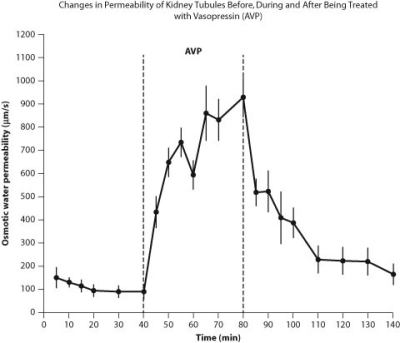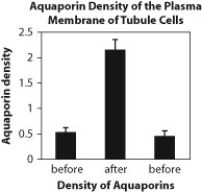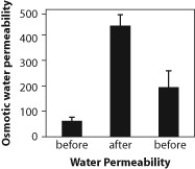Water movement is important in urine formation in the kidneys. Urine is formed when the blood is filtered by the kidneys into kidney tubules. Three figures are presented here that relate to how the kidney tubules respond to the administration of the hormone vasopressin. The direction that water flows in these figures is from the kidney tubules back into the blood.
 Figure A. Changes in permeability of tubules in the kidney in response to the hormone vasopressin (AVP) , which aids in osmoregulation.
Figure A. Changes in permeability of tubules in the kidney in response to the hormone vasopressin (AVP) , which aids in osmoregulation.
 Figure B. Density of aquaporins in kidney tubule cells before, during, and after administration of vasopressin.
Figure B. Density of aquaporins in kidney tubule cells before, during, and after administration of vasopressin.
 Figure C. Permeability of tissues to water before, during, and after administration of vasopressin.
Figure C. Permeability of tissues to water before, during, and after administration of vasopressin.
-How do the data in Figure A relate to the data in Figures B and C?
Definitions:
Exchange Rates
How much one currency is worth in terms of another during conversion.
Liability Record
Liability Record is a documentation or entry that reflects the obligations or debts of a company that are due to be paid to others.
Forward Contract
A customized contract between two parties to buy or sell an asset at a specified price on a future date.
Gross Method
An accounting practice where purchases are recorded at their gross price, without deducting any discounts, which are recorded if and when they are received.
Q15: Which region had the least amount of
Q18: Which environmental factor has a direct effect
Q23: Which of the following metabolic pathways is
Q27: Which list accurately orders a food chain
Q37: A student wanted to plant an avocado
Q40: You are reading the journal of an
Q41: DNP is a chemical that has been
Q44: Which of the following statements regarding diffusion
Q53: Dinoflagellates are important to coral and coral-dwelling
Q54: If a projectile is fired straight up